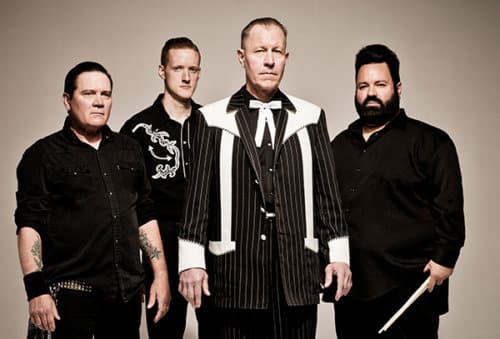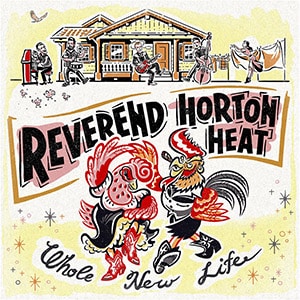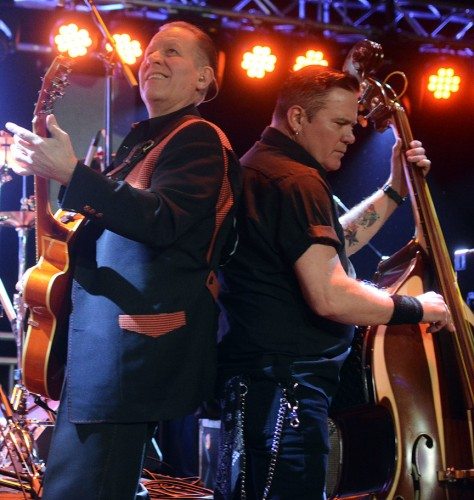
Maybe the style of music Reverend Horton Heat plays is called psychobilly because it’s crazy fun.
The 12th studio album, “Whole New Life,” is another masterpiece of rockabilly frolicsomeness. One of the new tunes is “Sunrise Through The Power Lines,” which suggests looking at the good side of a possible bad situation.
Case in point: The last time Reverend Horton Heat performed at the Cargo Concert Hall, the bar ran out of PBR tallboys. But concertgoers continued to dance and enjoy the show. Eventually, a new supply of the beer arrived.
“I am so glad that crisis was averted,” said the Reverend, who goes by Jim Heath offstage.
In the middle of the show, The Unknown Hinson was featured as the Rev’s band backed up. That’s a concert tradition ever since Motorhead’s Lemmy Kilmister came onstage during a show.
On Thursday, Feb. 14, Reverend Horton Heat returned to Cargo. The midshow solo feature star was Big Sandy, who has a Western swing band from California, Fly-Rite Boys. The opening bands are the Voodoo Glowskulls and Delta Bombers.
The Reverend was joined by Jimbo Wallace, a slap-style upright bass player who has been with his band exactly 30 years. The musicians’ speedy playing style matched their lifestyle.
“His gung-ho attitude really is what makes this thing go,” Heath said. “Our agent doesn’t even call me. He just books gigs. Me and Jimbo, we just play. A lot of bands, if a gig gets booked, there’s got to be a big democratic vote on whether they should play the gig. That would really slow us down. We can’t slow down for that. Just book the gigs. Tell me where I’m going.”
Reverend Horton Heat continues to relentlessly perform. And that’s the inspiration for a unique track on the new record, “Hate to See You Cry,” which is about Heath’s daughters.
“Having a daddy who’s on the road 150 days of the year, it’s just heartbreaking,” he said.
 And even though it’s a sad song, in typical Reverend Horton Heat fashion, it’s up tempo.
And even though it’s a sad song, in typical Reverend Horton Heat fashion, it’s up tempo.
“Us rockabilly guys, we love the Sam Phillips slap-back tape echo,” Heath said. “I put that on everything almost all the time, I am so into it. But ‘On Hate to See You Cry,’ I went to no effects except a little bit on the compression and that gives it this very personal type of feel. The vocals are just dry and right there in your face.
“I like producing our records a whole lot. I like engineering the recording sessions. I like mixing. I just love being in my studio. I could be in there 12 hours and not even realize, oh my gosh, it’s 3 in the morning. I better go home.”
Heath wrote 10 of the 11 songs on “Whole New Life,” with the lone cover being the concluding track, “Viva Las Vegas,” which Heath describes as overly Elvis.
There’s also a nod, or more of a frenzied head shake, to Roy Orbison on positively facetious “Perfect.”
And there’s also a tip of the hat to Professor Longhair and the New Orleans club made in his honor, Tipitinas. “Tchoupitoulas Street” showcases pianist Matt Jordan, who is now a full-time band member. Tim Alexander, who died in 2017, had been the studio session and local show piano player.
Heath shows off his newfound vocal chops throughout the album. The guitarist who once backed Screaming Jay Hawkins does a lot of screaming himself.
“I got a vocal coach and started working on extending my range and that’s helped a whole lot with this whole thing,” Heath said. “Jimbo goes, ‘You’ve got a vocal coach and now your making a bunch of crazy noises. You’re just screaming.’ ”
The yelps and whoops punctuate frenzied rockabilly licks played on a custom Gretsch 6120 RHH, which came about in a “Sunrise Through The Power Lines” way.
Heat played a Duane Eddy Gibson until he accidentally created the literal definition to scorching guitar.
“I spaced out and left it in the trunk of my car and it basically melted,” said Heath, who was left wandering a Guitar Center in the middle of a tour.
“I saw the reissue Gretsch and it’s a wide body — that’s what I was used to,” He said. “The wide body with a Bigsby (vibrato). The Gretsch has more twang. (Later) I switched to Gretsch White Falcon.

Tim Parsons / Tahoe Onstage
The Gretsch guys called me up, they were watching a video where I was playing the Orange 6120, and they said ‘we want to build a Reverend Horton Heat model Gretsch.’ They came out great. They’ve given me four of them. Jimmy Vivino on Conan O’Brien plays one. Jimmy told me he thinks it’s the best model Gretsch that they make.”
Rockabilly is a word combination of rock ‘n’ roll and hillbilly. Hollowbody guitars are conducive to the crisp sound, which was pioneered by white Southerners emulating Delta blues, such as Johnny Burnette, Sonny Burgess and Scotty Moore, and recorded at Sam Phillips’ Sun Studio in Memphis.
Heath said his favorite celebrity story was from the time he met “The King of Rockabilly,” Carl Perkins, who wrote “Blue Suede Shoes” and had his songs covered by Elvis Presley, The Beatles and Jimi Hendrix.
“In the early days of his career and Johnny Cash’s career, they were on tour together and Johnny Cash wrapped two M-80 fireworks together in the hotel room they were all staying in,” Heath said. “He lit it on fire. Johnny Cash figured if he flushed it down the toilet it would put out the fuse. But those fuses don’t go out even when submerged under water. So he flushed it down the toilet and with the compression of the pipes it was like a full on bomb going off.
“I asked Carl Perkins if it was true. He said, ‘Oh yeah, it blew some old boy off his toilet.’ The cops saw what room it blew up and they were gonna arrest him. They were taking that guy to jail. But Johnny Cash goes out there and said, ‘No, it was me. I did it.’ A lot of people don’t know it, but he made payments on that for 25 years.”
Now that’s some crazy fun.
— Tim Parsons
